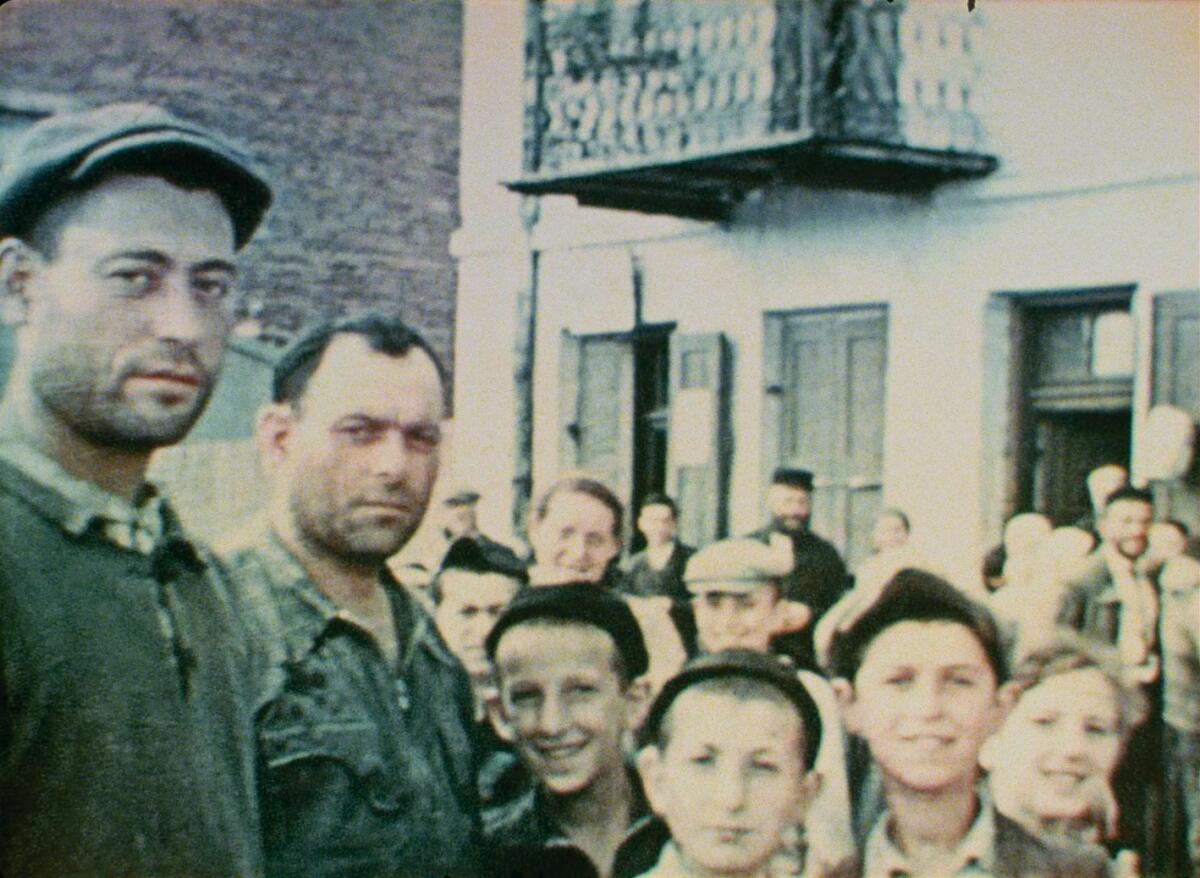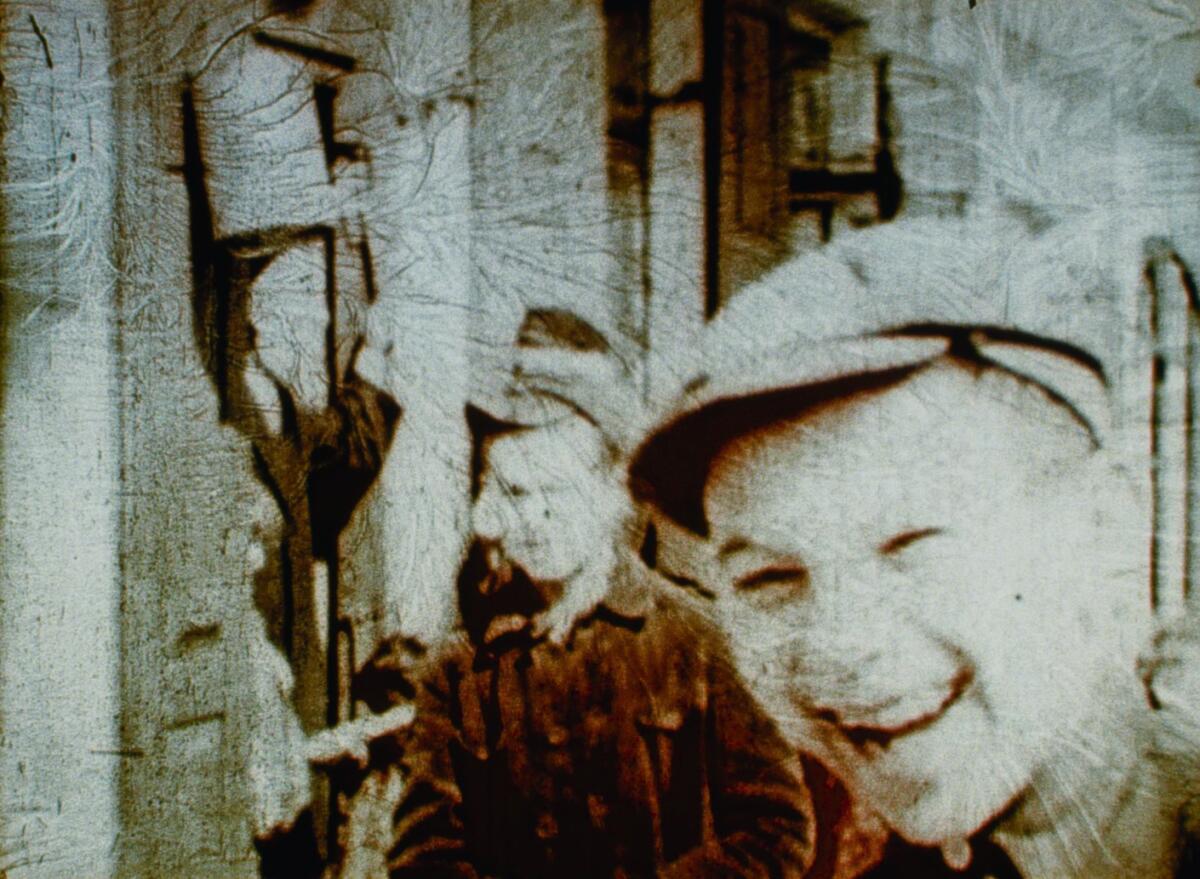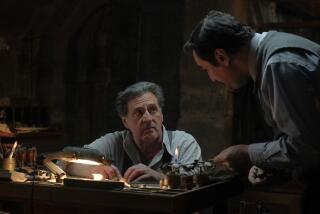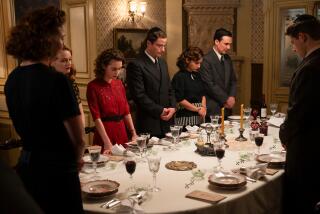Review: The haunting Holocaust doc ‘Three Minutes: A Lengthening’ finds mystery in minutiae

The snippets of footage that are played and replayed in “Three Minutes: A Lengthening” open a window — smudged, weathered, mysterious, revelatory — onto a world that no longer exists.
To some extent, as noted by one of the interlocutors in this probing and ruminative essay film, this is the fate of most filmed nonfiction material, since the reality being documented is always in flux. But the weight of history lends these specific images an especially stark, sobering power. Shot by a young Polish American émigré, David Kurtz, during a 1938 summer trip back to his hometown of Nasielsk, they represent the only known cinematic record of life in this tiny village before most of its 3,000 Jewish residents were deported and murdered in the Holocaust.
To see the townspeople in these 16-millimeter Kodachrome images, gathering in a cobblestoned square or filing out of synagogue, is to be haunted by the grim knowledge of what awaits them in a little more than a year’s time. But if Kurtz’s footage — unearthed years later by his grandson, Glenn Kurtz — is a snapshot of a community in the looming shadow of death, it is nonetheless an insistent, even defiant repository of life. And there is so much life in the faces of these men, women and children, especially as they react to the unprecedented sight of a movie camera in their midst. Some of them gleefully mug and wave; others self-consciously yank their loved ones out of the way.
For your safety
The Times is committed to reviewing theatrical film releases during the COVID-19 pandemic. Because moviegoing carries risks during this time, we remind readers to follow health and safety guidelines as outlined by the CDC and local health officials.
Directed by the Dutch historian and cultural critic Bianca Stigter and crisply narrated by Helena Bonham Carter, “Three Minutes: A Lengthening” expresses its own fascination with — and skepticism toward — the properties of the movie camera. To ensure maximal immersion, Stigter keeps those roughly three minutes of footage front and center for the movie’s 69-minute running time, sometimes freezing, slowing down or zooming in on the images, but never cutting away from them. The voices we hear are all disembodied, including that of Glenn Kurtz, who describes his efforts to identify as many of the individuals in his grandfather’s footage as possible. (Those efforts were also chronicled in his 2015 book, “Three Minutes in Poland: Discovering a Lost World in a 1938 Family Film.”)

Like other filmmakers determined to do right by the gravity of their subject, Stigter (who served as an associate producer on Steve McQueen’s “12 Years a Slave” and “Widows”) pursues her investigations with impressive formal spareness and a rigorously self-questioning spirit. She knows that every documentary image is both a representation and a distortion, a captured reality that excludes and decontextualizes as much as it reveals. Few of the faces we see, someone points out, are likely to belong to the town’s Orthodox Jewish population, as they would have been wary of appearing on camera. To properly parse the town’s cultural, religious, economic and class dynamics — to get a sense of how life here was truly lived — would require more research and study than three minutes of amateur camerawork can provide.
At the same time, the dearth of other images of pre-World War II Nasielsk is precisely what renders David Kurtz’s footage both so vital and so slippery — and also, finally, so interesting. Stigter and Glenn Kurtz puzzle over the mysteries buried within the footage, like the meaning of the barely legible sign hanging over a local market. What family owned this establishment? What were the other townspeople’s names? (Only about 80 Jews from Nasielsk survived the war; a few of their voices make their way into the movie.) As the investigation deepens, stories from the village come pouring out, one of them about the button factory that was one of Nasielsk’s most thriving and reputable businesses. Another illuminates the history of the Lion of Judah symbols engraved on the doors of the synagogue; their defacement offers a sad reminder, if one were needed, that this and other predominantly Jewish towns have never been strangers to antisemitic violence.
These three minutes, in other words, contain multitudes, as does this economical but richly expansive documentary. “Three Minutes: A Lengthening” is a snapshot, a memorial, a knotty philosophical detective story and a devastating account of Nazi atrocities. It’s also an extended rumination on the illusory, entropic nature of the cinematic medium itself. Carter’s narration draws our attention to the footage’s faded, muted colors, the warping and buckling of the images, the once-sharp outlines of faces and figures that have turned murky and indistinct. The artifacts of the past are as prone to damage and decay as our memories, which is all the more reason to cherish them in the present.
Watch L.A. Times Today at 7 p.m. on Spectrum News 1 on Channel 1 or live stream on the Spectrum News App. Palos Verdes Peninsula and Orange County viewers can watch on Cox Systems on channel 99.
‘Three Minutes: A Lengthening’
Rating: PG, for thematic material involving the Holocaust
Running time: 1 hour, 9 minutes
Playing: Starts Aug. 19 at Laemmle Royal, West Los Angeles
More to Read
Only good movies
Get the Indie Focus newsletter, Mark Olsen's weekly guide to the world of cinema.
You may occasionally receive promotional content from the Los Angeles Times.








